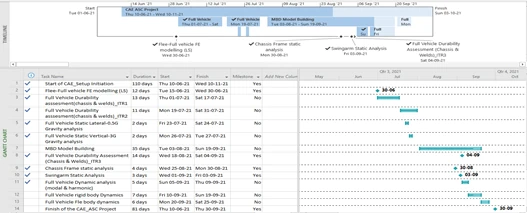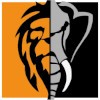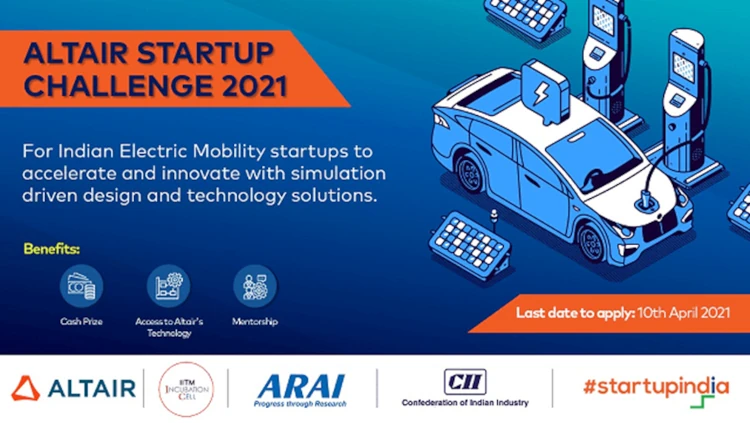At the beginning of April 2022 Coexlion expanded their analysis capabilities with the addition of Shreyas Ravi to the team. Shreyas comes with a background in motorsport engineering from the UK and is a recent winner of the Altair start-up challenge in India. See below for his review of the competition and the key to his success…
The Altair start-up challenge is an annual competition between the most coveted start-ups across India. The event started in 2019 with Altair looking to mentor start-ups on simulation driven design and technology solutions, and at the same time promote the full capabilities of their software. The competition is a collaboration of Indian industry giants with ARAI, CII and Startupindia being few of the big names to be involved. Experts from various backgrounds and industries come together to guide and judge the final stages. They bring tons of design and simulation experience as they hold senior position in their respective industries. With such exposure and a cash prize involved, many start-ups and engineers want to be part of this.
In my former company I oversaw coordinating the Altair start-up challenge, due to my position within the CAE team. The competition was judged over three rounds, with each phase posing a different set of presentation related challenge from documentation to videos and the conventional ppts.
SECOND ROUND
The next round revolved around a progress presentation at about three months mark of the competition. Altair was very supportive in between the sessions and therefore was aware of what is happening with the teams. There is no bluffing possible in this competition. Our product allowed us to fully utilise all the facilities offered by the software giant. The CAE team had frequent office visits from Altair personnel for in-person support. It was a great opportunity for us to not just polish up our basics and Analysis skills but also understanding of the software. I believe we were successful in this round as we had a process plan defined at the start of this phase, and we were on schedule. I would recommend that anyone embarking on this challenge spend time to plan and make every effort to stick to it.
Our plan involved conducting full vehicle durability assessment on chassis structure, in particular the weld regions; Full vehicle static longitudinal (0.5G) analysis; full vehicle static vertical (3G) analysis; Component level static analysis; full vehicle dynamic analysis (modal & harmonic) and finally MBD (Multi-Body Dynamic) modelling. Apart from the virtual scenarios the vehicle was loaded with strain gauges and accelerometers to conduct RLDA (Road Load Data Acquisition). This was to validate our virtual simulation scenarios and to further fine tune the simulation and modelling with real-life. RLDA testing provided us with great insights on the industrial validation and testing techniques.
One of the toughest parts of this round for me personally involved making a video. Even though I felt very camera shy, I featured in the video. We finished round 2 in 3rd position in the points table (so, maybe the video wasn’t all that bad!).

THIRD ROUND
We progressed in to the third round and there wasn’t much of a headroom in terms of time between rounds. In the couple of months that we had, the focus was to get the product production ready. This diversion of focus led to a slight drift in timings with the Altair challenge. We missed some key deadlines. MBD modelling could not be finished. It is perhaps not surprising as MBD modelling of a 2-wheeler product has well documented challenges. In anything other than in plane dynamics, 2 wheelers are incredible sensitive to tyre data, and rider mass and position adds a significant unpredictable variable. The few months between rounds 2 and 3 were too short to experiment with vehicle dynamics even without the team being caught up on production readiness of the vehicle. The challenging part here was “focus shift”. Typically, in a start-up there are usually fewer people covering multiple work areas, in quite a fluid way. Even though the plan initially seemed to be achievable, the big variable not foreseen during planning, was the production work pressure, and it led to missing of the deadlines.
Despite the production pressures, we did complete the vehicle level, static, fatigue, harmonic and modal analyses and presented the results. We also conducted component level static and fatigue analysis on parts that were observed to have required some design modification during initial prototyping stages. This work dovetailed well with the production development requirements and the competition, as we were working on real development issues. These parts were initially developed with very little CAE conducted and only pre-liminary material testing. We managed to correlate our simulation with RLDA and product testing and validation (Road drives). Achieving our goal of not just participating in the competition, but also genuinely developing and optimising our product design using Altair simulation tools design.
We presented our work in a virtual presentation, showcasing the design changes made to address the issues highlighted in both static and fatigue simulation results. The judging panel included members from ARAI, TATA, CII, Startupindia, ministers, etc. Frustratingly, I was only a silent spectator in the final virtual presentation as I was recovering from a recent attack by this vicious apparently novel virus known as covid and could not utter a word as I’d lost my voice. I did barge in on few of the questions later in the presentation though.
RESULTS
The experience of all this was surreal to say the least. There were 8 teams that made it to the final round, all worthy of winning. One team had already found fame from the TV program Shark Tank. While some teams were making big names for themselves in the wider world already. So, when the winners were announced 5 days later and we were at the top of the list, we could not believe it! The judging panel in their comments lauded our efforts. But perhaps more importantly for our own development pointed out mistakes (major ones on occasions). Thankfully, they were mightily impressed by the simulation-based design changes made to the vehicle. It fit perfectly the description of what Altair was trying to do with start-up challenge. Which was to imbed the use of analysis software in the design and development process, to help resolve exactly this type of issue.
SUMMARY
As an overall summary, I would say that to win, even against established teams is not so hard. You just need to understand the requirements of the competition. Many teams make a strategy to win points, as per the competition scoring systems. However, we found that to focus on the analysis process and to embed the software into our daily work was a bigger and more fun challenge. We focussed on getting the processes right for the benefit of our product. We never worried about what our points or finishing position would be, and that I think was where we won. As we were more in line with the spirit of the competition. By using the tools thoroughly to improve the product, we naturally took care of the points! We learned more by taking this approach.
Overall, would I recommend entering the Altair Start-up challenge? I’d have to say yes. Although a bit hectic at times, and the task of uploading the presentations on the Altair cloud link can be very tedious at times (it just never seemed to work!). I think the benefits out way these minor issues. Yes, it does take a lot of time, but the time spent with the in-depth analysis was valuable to our daily work. The competition drove improvement in the product, as well as taking our analysis skills to another level altogether, not to mention our confidence in presentations. I’m still not too comfortable in front of the camera though! (Better off behind the lens).
Thank you for reading this months blog, Altair Start-Up Challenge (India) In Review.
COEXLION
Coexlion

